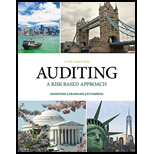
Concept Introduction:
Audit means an independent examination of the books of accounts or financial statements of a company. Audit includes many things like audit plan, audit program, audit documentation, etc. The last phase of the audit is to make an opinion over the financial statement of the company.
To choose: The procedure which is not followed in phase V of audit.
b. Performance of preliminary analytical review procedures.
Correct answers:
b. The performance of preliminary analytical review procedures has happened in phase I of audit because it includes taking knowledge of the company’s work.
Incorrect answer:
a. Assessment of misstatement detected during the course of audit is happen in phase V of the audit. All substantive procedures and test control are done in phase V.
c. Performance of an engagement quality review is happening in the last phase of the audit in which auditors perform a quality review. So it is also included in Phase V.
d. Determination of the appropriate audit opinion is also in the last phase of the audit i.e. phase V of the audit.
Want to see the full answer?
Check out a sample textbook solution
Chapter 5 Solutions
Auditing: A Risk Based-Approach (MindTap Course List)
- Can you help me solve this general accounting problem with the correct methodology?arrow_forwardI need the correct answer to this general accounting problem using the standard accounting approach.arrow_forwardAt the beginning of the year, Ashton Industries has assets of $275,000 and equity of $185,000. During the year, assets increase by $95,000 and liabilities increase by $65,000. What is the equity at the end of the year?arrow_forward
- Oakridge Hardware has assets equal to $475,000 and liabilities equal to $290,000 at year-end. What is the total equity for Oakridge Hardware at year-end?arrow_forwardPlease provide the solution to this financial accounting question with accurate financial calculations.arrow_forwardI need help with this financial accounting problem using accurate calculation methods.arrow_forward
- I need guidance with this general accounting problem using the right accounting principles.arrow_forwardPlease provide the correct solution to this financial accounting question using valid principles.arrow_forwardPlease help me solve this general accounting question using the right accounting principles.arrow_forward
 Auditing: A Risk Based-Approach (MindTap Course L...AccountingISBN:9781337619455Author:Karla M Johnstone, Audrey A. Gramling, Larry E. RittenbergPublisher:Cengage Learning
Auditing: A Risk Based-Approach (MindTap Course L...AccountingISBN:9781337619455Author:Karla M Johnstone, Audrey A. Gramling, Larry E. RittenbergPublisher:Cengage Learning Auditing: A Risk Based-Approach to Conducting a Q...AccountingISBN:9781305080577Author:Karla M Johnstone, Audrey A. Gramling, Larry E. RittenbergPublisher:South-Western College Pub
Auditing: A Risk Based-Approach to Conducting a Q...AccountingISBN:9781305080577Author:Karla M Johnstone, Audrey A. Gramling, Larry E. RittenbergPublisher:South-Western College Pub


